| |
|
Xiamen Oil Paintings, Wholesale Direct!
|
|
100% hand painted, 100% cotton canvas, 100% money back if not satisfaction. |
|
|
|
|
ART WORKS INDEX
A
B
C
D
E
F
G
H
I
J
K
L
M
N
O
P
Q
R
S
T
U
V
W
X
Y
Z
|
|
ARTISTS INDEX
A
B
C
D
E
F
G
H
I
J
K
L
M
N
O
P
Q
R
S
T
U
V
W
X
Y
Z
|
|
|
|
 |
Lucien Pissarro
|
|
French Camden Town Group Painter, 1863-1944
was a French painter, printmaker and wood engraver. Eldest son of the Impressionist painter Camille Pissarro, he was born in Paris and studied with his father. His works employ techniques of Impressionism and its successor, Neo-impressionism, but he also exhibited with Les XX. From 1890 he lived in London, becoming a British citizen in 1916. While in England he was one of the founders of the Camden Town Group of artists. In 1919, he formed the Monarro Group with J.B. Manson as the London Secretary and Theo van Rysselberghe as the Paris secretary, aiming to show artists inspired by Impressionist painters, Claude Monet and Camille Pissarro.
|
|
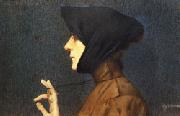 |
Lucien Levy-Dhurmer
|
|
French Art Nouveau Painter, 1865-1953,was a French Symbolist/Art Nouveau painter and potter. He was born Lucien Levy to a Jewish family in Algiers. In 1879 he began studying drawing and sculpture in Paris. In 1887 Levy began making his living in southern France, overseeing the decoration of ceramics. His own tastes in pottery decoration were influenced by Islamic Art. In 1895 he left for Paris to begin a career in painting; around this time he visited Italy and was further influenced by art of the Renaissance. In 1896 he exhibited his first pastels and paintings under the name Lucien Levy-Dhurmer; he'd added the last two syllables of his mother's maiden name (Goldhurmer), likely to differentiate himself from other people named Levy. His paintings soon became popular with the public and among fellow artists as well. He earned high praise for the academic attention to detail with which he captured figures lost in a Pre-Raphaelite haze of melancholy, contrasted with bright Impressionist colouration. His portrait of writer Georges Rodenbach is perhaps the most striking example of this strange and extraordinary synergy.
|
|
|
|
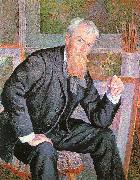 |
Luce, Maximilien
|
|
French Pointillist Painter, 1858-1941
French painter and printmaker. He was born and brought up in the working-class surroundings of Montparnasse, and an interest in the daily routines and labours of the petit peuple of Paris informs much of his art. After an apprenticeship with the wood-engraver Henri Theophile Hildebrand (b 1824), in 1876 he entered the studio of the wood-engraver Eugene Froment where he assisted in the production of engravings for various French and foreign publications such as L'Illustration and The Graphic. He also sporadically attended classes at the Academie Suisse and in the studio of Carolus-Duran. In Froment's studio he came into contact with the artists Leo Gausson and Emile-Gustave Peduzzi
|
|
|
|
|
|
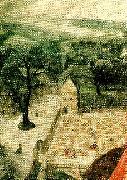 |
lucas van valchenborch
|
|
Lucas van Valkenborch (also "Valckenborch," "Valkenborgh") (c. 1535, Leuven - February 2, 1597, Frankfurt am Main), was a member of a family of Flemish landscape and genre painters.
|
|
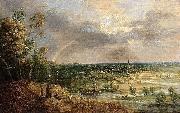 |
Lucas van Uden
|
|
(18 October 1595 - 4 November 1672) was a Flemish Baroque painter specializing in landscapes.
Lucas van Uden was born in Antwerp, where he entered the guild of St. Luke in 1626-27. Although he was never part of Peter Paul Rubens's studio, his works are partly indebted to that master. Van Uden even made copies of Rubens's works on several occasions. His technique, however, owes as much to earlier painters like Joos de Momper and Jan Brueghel the Elder. General characteristics are a tonally-green recessive view punctuated by slender trees and populated by incidental pastoral and peasant figures. Many of Van Uden's figures were either copied from Rubens or painted by David Teniers the Younger. He is often associated with fellow landscape painter Jan Wildens.
|
|
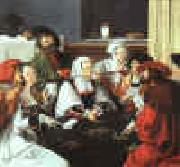 |
Lucas van Leyden
|
|
1489-1533 Dutch Lucas van Leyden Galleries Lucas van Leyden (Leiden, 1494 ?C August 8, 1533 in Leiden), also named either Lucas Hugensz or Lucas Jacobsz, was a Dutch engraver and painter, born and mainly active in Leiden, who was among the first Dutch exponents of genre painting and is generally regarded as one of the finest engravers in the history of art. He was the pupil of his father, from whose hand no works are known, and of Cornelis Engelbrechtsz, but both of these were painters whereas Lucas himself was principally an engraver. Where he learnt engraving is unknown, but he was highly skilled in that art at a very early age: the earliest known print by him (Mohammed and the Murdered Monk) dates from 1508, when he was perhaps only 14, yet reveals no trace of immaturity in inspiration or technique. Lot and his daughters (ca. 1509)In 1514 he entered the Painters' Guild at Leiden. He seems to have travelled a certain amount, and visits are recorded to Antwerp in 1521, the year of D??rer's Netherlandish journey, and to Middelburg in 1527, when he met Jan Mabuse. An unbroken series of dated engravings makes it possible to follow his career as a print-maker and to date many of his paintings, but no clear pattern of stylistic development emerges. D??rer was the single greatest influence on him, but Lucas was less intellectual in his approach, tending to concentrate on the anecdotal features of the subject and to take delight in caricatures and genre motifs. Carel van Mander characterizes Lucas as a pleasure-loving dilettante, who sometimes worked in bed, but he left a large oeuvre, in spite of his fairly early death, and must have been a prodigious worker. Lucas had a great reputation in his day (Vasari even rated him above D??rer) and is universally regarded as one of the greatest figures in the history of graphic art (he made etchings and woodcuts as well as engravings and was a prolific draughtsman). His status as a painter is less elevated, but he was undoubtedly one of the outstanding Netherlandish painters of his period. He was a pioneer of the Netherlandish genre tradition, as witness his Chess Players (Gemäldegalerie, Berlin) which actually represents a variant game called 'courier' - and his Card Players (National Gallery of Art, Washington), while his celebrated Last Judgement triptych (Lakenhal Museum, Leiden, 1526-27) shows the heights to which he could rise as a religious painter. It eloquently displays his vivid imaginative powers, his marvellous skill as a colourist and his deft and fluid brushwork.
|
|
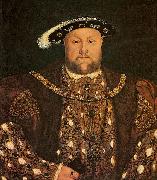 |
Lucas Horenbout
|
|
Lucas Horenbout, often called Hornebolte in England, (Ghent c. 1490 to 1495 - London 1544) was a Flemish artist who moved to England in the mid-1520s and worked there as "King's Painter" and court miniaturist to King Henry VIII from 1525 until his death. He was trained in the final phase of Netherlandish illuminated manuscript painting, in which his father Gerard was an important figure, and was the founding painter of the long and distinct English tradition of portrait miniature painting. He has often been suggested as the Master of the Cast Shadow Workshop, who produced royal portraits on panel in the 1520s or 1530s.
Horenbout trained in Ghent with his father, Gerard Horenbout, becoming a Master of the local Guild of Saint Luke in 1512. Gerard was an important Flemish manuscript illuminator in the dying days of that art-form, who had been court painter, from 1515 to about 1522, to Margaret of Austria, Regent of the Netherlands. Margaret was twice sister-in-law to Catherine of Aragon, still Henry's (first) Queen when the Horenbouts came to England. Gerard is sometimes identified with the "Master of James IV of Scotland", one of the many artistic personalities identified as a significant illuminator in the Ghent-Bruges school of the period, to whom no historical person can be attached.
Horenbout came over to England at an unknown date with, or perhaps before, his sister Susanna and his father. It has been suggested that their move was in connection with an attempt by the King, or possibly Cardinal Wolsey, to revive English manuscript illumination by establishing a workshop in London, but this is controversial. His father Gerard is first recorded in England in 1528, and later returned to the Continent, probably after 1531; he had died in Ghent by 1540. Susanna, who was also an illuminator, is recorded in 1529 as married to a John Palmer and in England.
Lucas is documented in England from September 1525, when he was first paid by the King as "pictor maker". By 1531 he was described as the "King's Painter", and this appointment was confirmed for life in June 1534, when he became a "denizen" - effectively a naturalised citizen. Horenbout was very well paid, at sixty-two pounds and ten shillings (but only thirty-three pounds and six shillings according to Richard Gay) per year, a "huge" sum according to Strong, and better than Holbein's thirty pounds a year in his period as Henry's court painter. He was granted a "tenement" in Charing Cross, and permitted to take on four foreign journeyman. Lucas was buried at Saint Martin in the Fields and left a wife and daughter, Margaret and Jacquemine. Margaret was paid sixty shillings three years later by Queen Catherine Parr for some paintings.
|
|
|
|
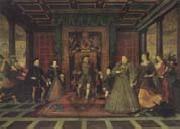 |
Lucas de Heere
|
|
1534-1584,Painter, tapestry designer, draughtsman and poet. He was probably trained by his parents. The suggestion that he became a member of the Ghent Guild of St Luke before 1540 was derived from an incorrect interpretation of the Guild records for 1574-5. Van Mander recorded that, as a boy, de Heere accompanied his father on his trips to the stone-quarries of the Meuse region, where he made topographical drawings. Lucas was sent to Frans Floris's studio c. 1555 or shortly before to complete his training, and he may have collaborated with his master on tapestry cartoons and stained-glass designs, although no cartoons or preparatory drawings survive. During this period de Heere also became noted as a poet in the local rhetoricians' chambers. His father's influence helped him to gain commissions in Ghent from 1555, and, according to Marcus van Vaernewijck (1568), he worked on new stained-glass windows for the St Janskerk in Ghent in the same year.
|
|
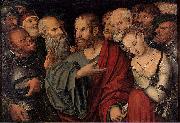 |
Lucas Cranach the Younger
|
|
(October 4, 1515 ?C January 25, 1586) was a German Renaissance artist, known for his woodcuts and paintings.
He was a son of Lucas Cranach the Elder who began his career as an apprentice in his father's workshop. Henceforth, his own reputation and fame grew. After his father's death, he assumed control over the workshop.
The style of their paintings can be so similar that there have been some difficulties in attribution of their works.
|
|
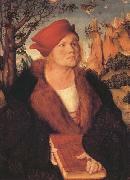 |
Lucas Cranach the Elder
|
|
b. 1472, Kronach, d. 1553, Weimar. German painter and printmaker. He took his name from the town of his birth. Little is known about his early life or training. In Vienna (c. 1501 ?C 04) he painted some notable portraits and landscapes characteristic of the Danube school. From 1505 to 1550 he was court painter in Wittenberg, where he achieved great success and wealth painting portraits, mythological subjects, and altarpieces for Protestant and Catholic churches. He attracted so many young artists to Wittenberg that the town became an art centre. A friend of Martin Luther, Cranach became known as the chief pictorial propagandist of the Protestant cause in Germany. He produced numerous engravings and more than 100 woodcuts, notably for the first German edition of the New Testament (1522). After his death, his style was perpetuated by his son, Lucas the Younger (1515 C 86).
|
|
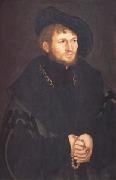 |
Lucas Cranach
|
|
Kronach 1472-Weimar 1553
German painter and engraver. The son of a painter, he settled in Wittenberg c.1504 and was court painter successively under three electors of Saxony. There he maintained a flourishing workshop and was twice burgomaster. Cranach was a close friend of Martin Luther, whose doctrine he upheld in numerous paintings and woodcuts, and he has been called the painter of the Reformation. He was a rapid and prolific painter, and the work turned out by his studio is uneven in quality. Naïve and fanciful, often awkward in draftsmanship, it has, nonetheless, freshness and originality and a warm, rich palette. His portraits are particularly successful. Among his best-known works are Repose in Egypt (Gemäldgalerie, Staatliche Mus., Berlin-Dahlem); Judgment of Paris (Staatliche Kunsthalle, Karlsruhe); Adam and Eve (Courtauld Inst., London); and Crucifixion (Weimar). The latter contains figures of Luther and Cranach. His many famous protraits include those of Elector John Frederick and Self-Portrait (Uffizi). Cranach was also an accomplished miniaturist. He produced a few copperplates and designs for woodcuts. His son and pupil Lucas Cranach, the Younger,
|
|
|
|
 |
Lucas Cranach
|
|
1472-1553
German
Lucas Cranach Locations
Lucas Cranach the Elder was born at Kronach, Franconia. He was apparently trained by his father, Hans, a painter, and from 1495 to 1498 undertook work at Kronach for Coburg and Gotha. There is evidence that Cranach resided in Vienna between about 1500 and 1504. In 1504 he married Barbara Brengbier of Gotha; they had three daughters and two sons, Hans (died 1537) and Lucas the Younger (1515-1586), both of whom were painters.
In 1505 Cranach established residence at Wittenberg, where he was court painter to three successive electors: Frederick the Wise, John the Constant, and John Frederick the Magnanimous. Cranach was a prosperous and respected citizen. He owned several houses and land, held the office of councilor, and was a burgomaster. He also worked for other princely patrons and was a follower and lifelong friend of Martin Luther.
In 1550 Cranach followed John Frederick the Magnanimous to Augsburg, where the elector was in exile, and in 1552 accompanied him to Weimar. Cranach died in Weimar on Oct. 16, 1553.
|
|
 |
Luca Signorelli
|
|
Crtona 1441-1523
.Italian painter of the Umbrian school, who probably studied with Piero della Francesca. He worked in Cortona, where some of his paintings have remained. Subsequently he worked in the Cathedral of Perugia, in Volterra, and at Monte Oliveto before undertaking (1499) the decoration of the Cappella Nuova in the Orvieto Cathedral. There he represented the apocalyptic series of the Story of the Anti-Christ, the End of the World, the Resurrection of the Bodies, Paradise, and the Inferno, as well as figurations from antique poems and the Divine Comedy. The infernal scenes are remarkable for their imaginative evocation of fiends and tortures of Hell. Michelangelo was influenced by his powerful treatment of anatomy and the vivid realism he used for dramatic ends. Signorelli's paintings in the Vatican, where he went in 1508, were later sacrificed to make way for some of Raphael's work.
|
|
|
|
|
|
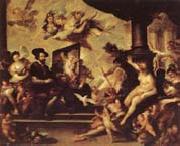 |
Luca Giordano
|
|
Italian Baroque Era Painter, ca.1634-1705
Italian painter and draughtsman, active also in Spain. He was one of the most celebrated artists of the Neapolitan Baroque, whose vast output included altarpieces, mythological paintings and many decorative fresco cycles in both palaces and churches. He moved away from the dark manner of early 17th-century Neapolitan art as practised by Caravaggio and his followers and Jusepe de Ribera, and, drawing on the ideas of many other artists, above all the 16th-century Venetians and Pietro da Cortona, he introduced a new sense of light and glowing colour, of movement and dramatic action.
|
|
|
|
 |
Luca Carlevaris
|
|
1665-1731
Italian
Luca Carlevaris Location
Luca Carlevarijs or Carlevaris (1663 - 1730) was an Italian painter of landscapes (vedutista).
Carlevarijs was born in Udine, but worked mostly in Venice. His veduta of Venice are among the earliest Baroque depictions of the city. He was influenced by the Dutch painter active in Rome, Caspar van Wittel (often called Vanvitelli). The painters Canaletto and Antonio Visentini are said to have been highly influenced by or pupils of his. Johan Richter did work with him.
|
|
 |
Luca Carlevarijs
|
|
Luca Carlevarijs or Carlevaris (20 January 1663 - 12 February 1730) was an Italian painter and engraver of landscapes (vedutista).
Carlevarijs was born in Udine, but worked mostly in Venice. His vedute of Venice are among the earliest Baroque depictions of the city. He was influenced by the Dutch painter active in Rome, Caspar van Wittel (often called Vanvitelli). The painters Canaletto and Antonio Visentini are said to have been highly influenced by or pupils of his. Johan Richter did work with him. Also called Luca Casanobrio or Luca di Ca Zenobri, for his patronage by the latter family.
He painted landscapes, sea-pieces, and perspective views. He completed over a hundred etchings of views in Venice, which give an exact representation of the principal places in that city. He died in Venice.
|
|
 |
Luca Cambiaso
|
|
Luca Cambiasi (surname also written Cambiaso or Cangiagio; 1527 - 1585) was an Italian painter and draftsman, familiarly known as Lucchetto da Genova.
|
|
 |
Luca Giordano
|
|
1632-1705
Italian
Luca Giordano Gallery
Charles II of Spain towards 1687 invited him over to Madrid, where he remained for 10 years (1692-1702). In Spain, he produced works for the Royal Palace of Madrid, the Buen Retiro palace, El Escorial, Toledo, and other sites. Giordano was popular at the Spanish court, and the king granted him title as a "caballero". One anecdote of Giordano's speed at painting is that, he was once asked by the Queen of Spain what his wife looked like. On the spot, he painted his wife into the picture before him for the Queen.
In Spain he executed numerous works, continuing in the Escorial the series commenced by Cambiasi, and painting frescoes of the Triumphs of the Church, the Genealogy and Life of the Madonna, the stories of Moses, Gideon, David and the Celebrated Women of Scripture, all works of large dimensions. His Dream of Solomon (1693, now at Prado) dates from this period. His pupils, Aniello Rossi and Matteo Pacelli, assisted him in Spain. In Madrid he worked more in oil-colour, a Nativity there being one of his best productions.
|
|
|
|
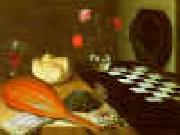 |
Lubin Baugin
|
|
1610-1663
French
Lubin Baugin Gallery
French painter. He became a master in the painters guild of Saint-Germain-des-Pras in 1629. From c. 1636 he was in Italy, but he is known to have been in Paris again in 1641; in 1645 he became a member of the Acadmie de St Luc, and in 1651 he was also a member of the Acadmie Royale after the temporary amalgamation of the two institutions. Like many of his generation he was deeply influenced by the art of the Fontainebleau school.
|
|
|
|
 |
Lovis Corinth
|
|
German Painter, 1858-1925
German painter and writer. He grew up on his family's farm and tannery. As a child he showed interest in art, taking informal lessons in drawing from a local carpenter and caricaturing his primary school teachers. Corinth's father sent him to secondary school in the nearby city of K?nigsberg (now Kaliningrad), where he lived with his widowed aunt. A superstitious woman fond of story-telling, she possessed what Corinth later described as a coarse temperament and an unrestrained, 'demonic' humour. These qualities and his aunt's bohemian acquaintances, including fortune-tellers and soothsayers, fascinated the young Corinth, accustomed to his more reserved parents.
|
|
|
|
|
|
 |
Louise-Catherine Breslau
|
|
(6 December 1856 - 12 May 1927) was a German/Swiss artist.
Born Maria Luise Katharina Breslau in Munich, Germany, she spent her childhood in Zurich, Switzerland and as an adult made Paris, France her home. Suffering from asthma all her life, Breslau turned to drawing as a child to help pass the time while confined to her bed. Although she became one of the most sought after portraitists of her time, after her death she and her work were all but forgotten. It has only been in the past few years that interest in Breslau and her works has been growing.
Breslau was born into a prosperous bourgeois family; her father was a well-respected physician specializing in obstetrics and gynecology. When Breslau was two years old, her father accepted the position of professor and head physician of Obstetrics and Gynecology at the University of Zurich; Switzerland became home to the Breslau family.
|
|
|
|
 |
Louise Rayner
|
|
Victorian Women Artists,English 1832 - 1924.
He was a British watercolor artist. Her parents, Samuel Rayner and Anne Rayner (nee Manser) were both noted artists, the former Samuel having been accepted for exhibition at the Royal Academy when he was 15. Four of Louise's sisters - Ann ("Nancy"), Margaret, Rose and Frances - and her brother Richard were also artists. The family lived in Matlock Bath and Derby before moving to London in 1842. Louise studied painting from 15, with the guidance of her father and later with artist friends such as George Cattermole, Edmund Niemann, David Roberts and Frank Stone. Her first exhibited work was entitled The Interior of Haddon Chapel, shown at the Royal Academy in 1852, the first of a series of oils. From 1860, however, her medium was watercolour, which she exhibited for over 50 years via organisations including the Society of Lady Artists, Royal Academy, Royal Watercolour Society and the Royal Society of British Artists. She lived in Chester but travelled extensively, painting British scenes, during the summers in 1870s and 1880s. Her paintings are very detailed and highly picturesque populated street scenes capturing the "olde worlde" character of British towns and cities. Her paintings are very popular today as prints and on jigsaw puzzles. Around 1910 she moved with her sister to Tunbridge Wells, and later to St Leonards, where she died in 1924.
|
|
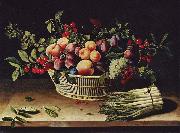 |
Louise Moillon
|
|
(1610-1696) was a French painter in the Baroque era. She became known as one of the best female still life painters during her time, and worked for King Charles I of England, as well as the French nobility.
Moillon came from a strict Calvinist family. Her father, brother Isaac, and stepfather were both paint dealers and artists themselves. According to the RKD, Louise (also known as Louisa) learned to paint from her father Nicolas Moillon and Francois Garnier. She gained her particular style of still life painting from the Academie de Saint-Germain-des-Pres. She usually signed her paintings with Louyse Moillon. Moillon lived and worked in France her whole life.
|
|
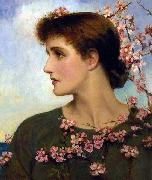 |
Louise Jopling
|
|
(16 November 1843 - 19 November 1933) was an English painter of the Victorian era, and one of the most prominent women artists of her generation.
Louise Goode was born in Manchester, fifth child of railway contractor T. S. Goode. She married at seventeen to civil servant Frank Romer. The Baroness de Rothschild, a connection of Romer's, encouraged Louise to pursue and develop her art. In the later 1860s she studied in Paris with Charles Joshua Chaplin and Alfred Stevens, and first exhibited her work at the Salon. She entered works into the Royal Academy shows, 1870-73 (as Louise Romer).
|
|
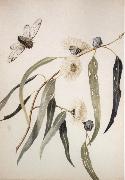 |
Louisa Anne Meredith
|
|
English miniaturist, watercolourist, engraver, poet, writer and botanist .
1812-1895
was an English and Australian writer and illustrator. Louisa Anne Meredith, the daughter of Thomas Twamley and Louisa Ann Meredith, was born near Birmingham, England on 20 July 1812. She was educated chiefly by her mother, and in 1835 published a volume, Poems, which was favourably reviewed. This was followed in 1836 by The Romance of Nature, mostly in verse, of which a third edition was issued in 1839. Another volume was published in the same year, The Annual of British Landscape Scenery, an account of a tour on the River Wye from Chepstow to near its source at Plynlimon. Shortly afterwards Miss Twamley was married to her cousin, Charles Meredith. Charles had emigrated to Van Dieman's Land in 1821 with his father George and family. They had been pioneers of grazing, whaling and other activities around Swansea on Tasmania's East Coast. Charles had become a squatter in the Canberra district of New South Wales They sailed for New South Wales in June 1839, and arrived at Sydney on 27 September 1839. After travelling into the interior as far as Bathurst, Mrs Meredith returned to the coast and lived at Homebush for about a year. By the time of his return to New South Wales, severe economic depression caused by excessive land speculation had destroyed the value of Charles' property, and towards the end of 1840 they relocated to Tasmania. An interesting account of her first 11 years in Australia is given in her two books, Notes and Sketches of New South Wales (1844), reprinted at least twice, and My Home in Tasmania (1852), which was soon republished in the United States of America under the title Nine Years in Australia. For much of her life Mrs Meredith lived on properties around Swansea. In 1860 she published Some of My Bush Friends in Tasmania which contained elaborate full-colour plates printed by the new chromolithography process. The illustrations were drawn by herself, and simple descriptions of characteristic native flowers were given. In the following year an account of a visit to Victoria in 1856, Over the Straits, was published, and in 1880 Tasmanian Friends and Foes, Feathered, Furred and Finned. This went into a second edition in 1881. In 1891, in her eightieth year, Mrs Meredith went to London to supervise the publication of Last Series, Bush Friends in Tasmania. Published at the outset of a severe financial depression in the Australian colonies, this project and the collapse of the bank where most of her savings were held ruined her financially. She died at Melbourne on 21 October 1895 and was survived by sons Owen and George. Mrs Meredith was the author of two novels, Phoebe's Mother (1869), which had appeared in the Melbourne weekly The Australasian in 1866 under the title of Ebba, and Nellie, or Seeking Goodly Pearls (1882). Mrs Meredith took great interest in politics, her husband Charles being a Member of the Tasmanian Legislative Council for several terms between the mid 1850s until just before his death in 1881.
|
|
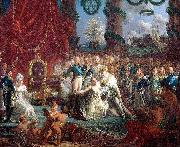 |
Louis-Philippe Crepin
|
|
(1772-1851) was a French naval painter, one of the first Peintres de la Marine.
Crepin was notably a pupil of Joseph Vernet and Hubert Robert.
His Combat de la Bayonnaise contre l'Ambuscade, 1798, depicting the Action of 14 December 1798, is one of the main exhibits of the Musee national de la Marine.
|
|
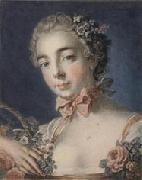 |
Louis-Marin Bonnet
|
|
French, 1736 - 1793
French engraver and publisher. He came from a family of artisans and owed his training in engraving to his brother-in-law, the engraver Louis Legrand (1723-1808). Through Legrand, Bonnet became the pupil of Jean-Charles Francois in 1756, a year before the latter discovered the CRAYON MANNER technique of engraving, designed to reproduce the effect of a coloured-chalk drawing. Around the end of 1757 Bonnet used the new technique to engrave a Cupid after Francois Eisen. Gilles Demarteau, a rival of Jean-Charles Francois
|
|
|
|
|
|
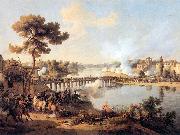 |
Louis-Francois, Baron Lejeune
|
|
(3 February 1775, Strasbourg - 29 February 1848) was a French general, painter, and lithographer. His memoirs have frequently been republished and his name is engraved on the Arc de Triomphe.
He studied painting in the studio of Pierre-Henri de Valenciennes, alongside Jean-Victor Bertin, but left the studio to volunteer in the Compagnie des arts de Paris in 1792. He received his baptism of fire in the battle of Valmy later that year. He became a sergeant in the 1st Arsenal battalion and in 1793 moved to the artillery at La Fere, assisting in the sieges of Landrecies, Le Quesnoy and Valenciennes. At Valenciennes he became aide-de-camp to general Jacob then, as a lieutenant on attachment to the engineers, took part in the 1794 Holland campaign and the 1795 campaign.
Called to the depot in 1798, he succeeded brilliantly in his exams and was made a captain on attachment to the engineers. He became aide-de-camp to marshal Berthier in 1800, a post he retained until 1812 and in which he took an active part in practically all of the Napoleonic campaigns. He was wounded and captured in Spain. He was promoted to full captain after Marengo and chef de bataillon after Austerlitz, also become a knight of the Legion d'honneur and a colonel at the Siege of Saragossa.
The German campaign of 1806 brought him to Munich, where he visited the workshop of Alois Senefelder, the inventor of lithography. Lejeune was fascinated by the possibilities of the new method and whilst there he made the drawing on stone of his famous Cossack (printed by C. and ~f. Senefelder, 1806). Whilst he was taking his dinner, and with his horses harnessed and waiting to take him back to Paris, one hundred proofs were printed, one of which he subsequently submitted to Napoleon. The introduction of lithography into France was greatly due to the efforts of Lejeune.
In 1812, during the French invasion of Russia, he was made general de brigade and chief of staff to Davout. Frostbitten on the face, Lejeune left his post during the retreat from Russia and was arrested on the orders of Napoleon. Freed in March 1813, Lejeune was then sent to the Illyrian provinces, before rejoining the army under the orders of marshal Oudinot, becoming his chief of staff. During the Saxony campaign, Lejeune was present at the Battle of Lutzen (1813), the crossing of the River Spree and at Bautzen. He was made an officer of the Legion d'honneur and a commander of the Order of Maximilian of Bavaria. At the battle of Hoyersverda, when Below's corps wiped out the 12th corps formed up in square on the plain, Lejeune (at risk of being kidnapped) ventured into the enemy lines with one battalion, general Wolf's cavalry and six 12 pounder guns. He thus broke the whole of the Prussian artillery and saved marshal Oudinot and his army. Wounded several times and lastly at Hanau, he was authorised to leave the army in November 1813 after more than 20 years' service. After his departure from the army, he devoted himself to painting.
|
|
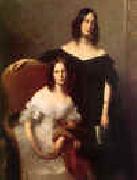 |
Louis-Edouard Dubufe
|
|
1819-1883 French
Son of Claude-Marie Dubufe. He was trained by his father and then by Paul Delaroche. He first appeared at the Salon in 1839 with the Annunciation, a Huntress and a portrait, winning a third class medal. He followed this in 1840 with an episode in the life of St Elisabeth of Hungary, which won him a second class medal; in 1844 he won a first class medal with Bathsheba and a genre scene set in the 15th century (all untraced).
|
|
|
|
|
|
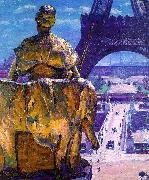 |
Louis Welden Hawkins
|
|
British
1849-1910
Louis Welden Hawkins Galleries
Louis Welden Hawkins was born in Germany ( 1 July 1849 ). His mother was an Austrian Baroness, his father Englishman. Hawkins moved soon to France and took later French nationality. Hawkins attended the famous Acad??mie Julian in Paris. Hawkins became famous after his expositions in the Salon de la Societe des Artistes Francais. His first work was shown in the Salon in 1881. After that, expositions followed at the Salon de la Societe des Beaux Artes (1894-1911), the Salon de la Rose-Croix (1894-95) and La Libre Esthetque in Brussels. He spended his last years in Brittany, where he painted mostly landscapes.
Louis Welden Hawkins died in 1910 and was honoured a year later at the Salon Nationale.
|
|
|
|
|
|
 |
Louis Rhead
|
|
Louis John Rhead (November 6, 1857 - July 29, 1926) was an English-born American artist, illustrator, author and angler who was born in Etruria, Staffordshire, England. He emigrated to the United States at the age of twenty-four.
|
|
|
|
|
|
|
|
|
| Wholesale China Oil Painting Wholesale Oil Painting China Xiamen Portrait Reproduction on canvas Chinese Oil Painting Wholesale USA Oil Painting |
|
|
|
|
|